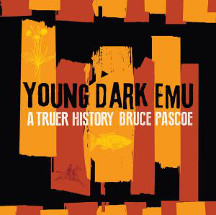Young dark emu by Bruce Pascoe

Magabala, 2019. ISBN: 9781925360844.
(Age: 9+) Highly recommended. Themes: Aboriginal themes, Aboriginal
agriculture, Aboriginal aquaculture. Coming across a reference to
Aboriginal agriculture sent Bruce Pascoe into researching a little
known area of Australian history. Saddled with the usual notion
taught in schools and believed by mainstream Australia, that
Aboriginal people were nomadic hunters and gatherers, Pascoe began
to look at diaries, recollections and illustrations by early
European settlers and explorers with different eyes. He came across
many examples of agriculture - sowing crops, harvesting, then
storing food, aquaculture and fish traps, of using fire and
constructing wells. And of villages where many families lived. Not
always sedentary many would have had two residences, taking into
account seasonal crops, sacred sites and their use of fire.
Pascoe published his significant findings in the book, Dark
emu (Magabala Books, 2014) and a radio interview with
ABC's Fran Kelly can be heard here.
Young dark emu is a version of his research rewritten for a
younger audience and a copy should be in every school, read and
discussed. It overturns the accepted view of Aboriginal life in
Australia prior to colonisation and shows how these people used the
land and its resources with knowledge, expertise and care.
Pascoe quotes explorers like Mitchell and Sturt who came across
villages where huts were constructed with mud caked over the
outside, where large groups of people lived, and fields with crops,
usually yam and grasses (it is estimated Aboriginal people
cultivated 140 different grasses). When Sturt and his men staggered
over the last sandhill of what is now Sturt's Stony Desert, they
were amazed to find an Aboriginal village where the men came out
with containers of water for the dehydrated explorers and their
horses. They were shown one of the huts to sleep in for the night
and given some wood with which to build a fire.
Many people have heard of the Brewarrina fish traps in northern New
South Wales, said to be the oldest human construction in the world.
Early colonists were amazed at how these worked, allowing juvenile
fish to escape while catching the older fish, enough for all. Fish
traps were also evident along the Murray and one extensive fish trap
along with a village was destroyed at Port Fairy in Victoria by
early settlers.
The evidence mounts up in Pascoe's book, divided into six chapters
about Aboriginal use of the land: Agriculture, Aquaculture, Home,
Food Storage and Fire, then Sacred Places. In his first chapter,
Pascoe tells us about the land grab that saw the colonisers take
over Aboriginal territory, ruining their crops, replacing the
animals with sheep, so destroying the land tilled by generations and
causing widespread starvation and consequently a reliance on
European food. Pascoe's compelling retelling of Australia's history
is beautifully illustrated with documents and images from the past,
all acknowledged in the Picture Credits at the end, along with a
detailed Index, Acknowledgements, Bibliography and information about
the author, Bruce Pascoe.
Pascoe likens our understanding of Aboriginal history to the image
of an emu in the night sky. Aboriginal people see the emu, a dark
space between the stars, whereas Europeans see the stars and the
shapes made by them. It is time we took a different perspective and
sought out those dark spaces to reassess our view of Australia prior
to colonisation and this book is the first step to that better
understanding.
Fran Knight